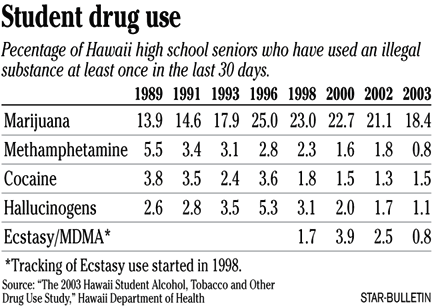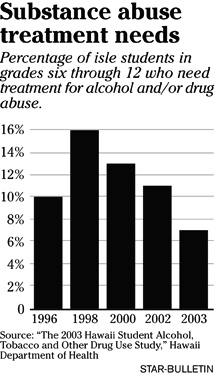‘Ice’ use plunges
for isle teens
An investigator for a state
study says all illicit drug use
is on the decline in Hawaii
Fewer Hawaii students are smoking, drinking or using drugs these days, with "ice" use falling to a record low in the latest confidential survey sponsored by the state Department of Health, released yesterday.
"Illicit drug use has been dropping across the board," said Renee Storm Pearson, principal investigator for the Hawaii Student Alcohol Tobacco and other Drug Use Study. "Not only marijuana, but methamphetamine and Ecstasy. Our lifetime use rates are lower than nationwide."
Four percent of seniors surveyed in November 2003 in Hawaii's public and private schools said they had ever tried "ice," or crystal methamphetamine, down from 12 percent in 1989. Meanwhile, the percentage of Hawaii seniors using the highly addictive drug in the last month dropped to less than 1 percent from 5.5 percent.
Nationally, 6 percent of high schools seniors surveyed in 2003 reported having tried meth, with nearly 2 percent using it in the last month.

The downward trend in substance abuse among Hawaii youth parallels a national pattern, but use rates are generally lower here than in the rest of the country. Despite the gains, Pearson warned against complacency.
"It's still alarming how high the percentages are," she said. "It's nowhere near down to the point where we don't have to worry that it's not going to climb again. That's why we need to keep focusing our energy on prevention."
Elaine Wilson, who retired last week as chief of the Alcohol and Drug Abuse Division of the Health Department, credited strong prevention, treatment and awareness efforts in recent years with pushing down the number of users.
"I think it's a reflection of three things," she said yesterday. "First is having early treatment available in schools. Second, we piloted prevention programs in 18 communities in the last three years that have reached many youth. And third, I think it also reflects the community organizing that happened in 2002 and 2003, when people were holding signs and giving out information that drugs are dangerous."

![]()

With fewer students experimenting, the need for substance abuse treatment has also declined. The percentage of students in grade six through 12 who qualify for treatment for alcohol and/or drug abuse dropped steadily to 7 percent in 2003 from its peak of 16 percent in 1998. Treatment needs are greatest on the Big Island and Maui.
More students who are eligible are taking advantage of services statewide. Nearly twice as many students who are diagnosed as needing treatment reported using a treatment facility in 2003 than in previous years, according to the report.
"Spending money on treatment programs makes a difference," Pearson said. "For instance, treatment programs are in almost every high school now. More kids are finding it easier to get access to help. This is not the time for us to start cutting resources ... because adolescent substance abuse is a dynamic beast."
The most popular substances among students are alcohol and marijuana. But drinking rates have dropped, and Hawaii's are lower than the national averages. More than a third of high school seniors here said they had had a drink within the last month; just more than half reported ever having been drunk.
Marijuana use has also fallen somewhat, with 18 percent of high school seniors in 2003 saying they had used it in the last month, down from a high of 25 percent in 1996. The national rate in 2003 was 21 percent.
Cigarette use has fallen to record lows in Hawaii. Sixteen percent of high school seniors here report having smoked a cigarette within the last month, compared with 24 percent nationally. Daily cigarette use here is less than half of the national average, at 7 percent compared with 16 percent.
Students reported greater difficulty in obtaining tobacco and alcohol since the state began a series of "sting" operations to reduce merchant sales.
www.hawaii.gov/health/substance-abuse/prevention-treatment/survey/adsurv.htm
[News] [Business] [Features] [Sports] [Editorial] [Do It Electric!]
[Classified Ads] [Search] [Subscribe] [Info] [Letter to Editor]
[Feedback]
